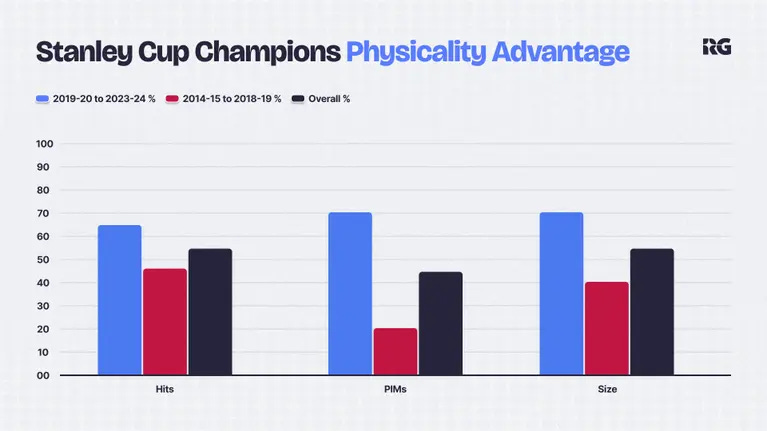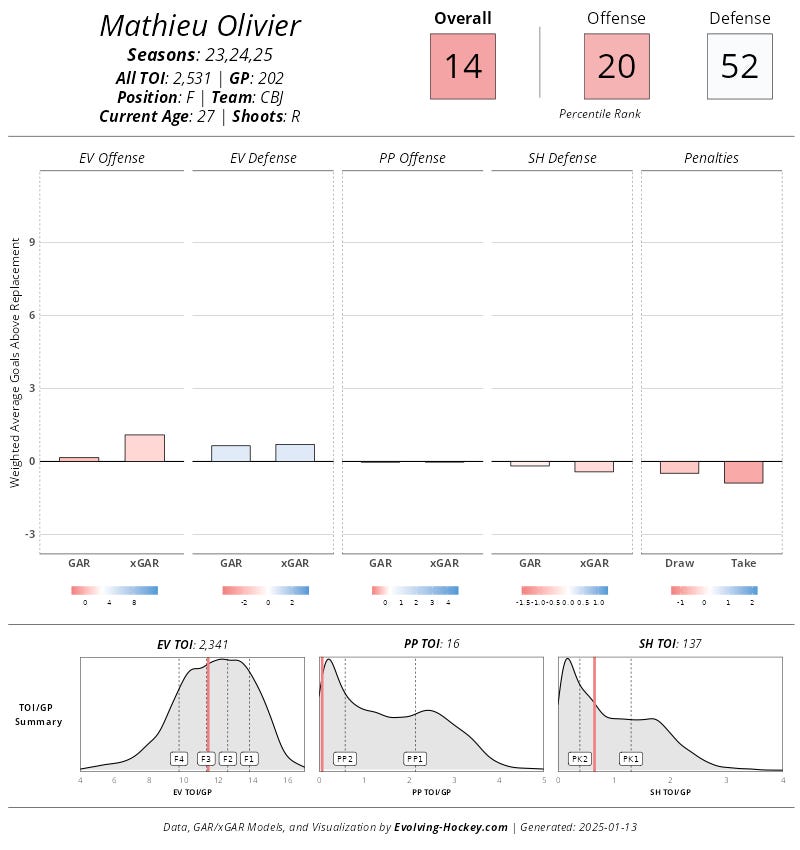I see this a lot from Stars fans, in the comments, and pretty much wherever you can find a hockey discussion about what a team “needs” in order to be successful. Even in last night’s loss to Ottawa, Brady Tkachuk had no problem bullying his way around the ice. After all1, the Stanley Cup playoffs are not just any sports journey. It’s sport as directed by Gareth Evans. Martial arts via the Grand Guignol. If you’re going into the corner for a puck, figure skating would be a less useful in a game that revolves around skating than being Saskatchewan-John Wick.
I have a lot of my own opinions about the ugly feedback loop this creates. After…all, if teams feel like they always need to be bigger and meaner in the big and mean Stanley Cup Playoffs, then big and mean will be the end product. Moreover, the border between heavy, physical hockey and predatory, violent hockey can be blurred — as it was with Matt Dumba on Joe Pavelski. Sam Bennett on Brad Marchand. I could list example after example after example2. In summation: Steve Dangle is right.
But you’re not here for my sermon on the Stack and really, neither am I. Because ultimately, you want to know whether or not toughness matters in hockey.
The generic answer is yes. In the same way that focus, commitment, and sheer will matter, so does toughness. That’s just the nature of competition. You have to be able to one-up your opponent in as many categories as possible. You have to be undeniable. In fact, for a rather deep and honest reflection about this entire discourse from a former-player perspective, I recommend reading Justin Bourne’s take at Sportsnet. I disagree with the logic, and even his conclusion almost completely, but I respect the thoughtfulness.
But what does this discourse mean in “per 60” terms? Dom Luszczyszyn, to my knowledge, was the first to take seriously that there was something to the notion of being bigger/meaner signaling playoff success. And he noticed it after analyzing the regular season and playoff splits of smaller, skilled players like Johnny Gaudreau (RIP) and Mitch Marner. For the most diminutive players—based on percentile—there was a noticeable gap. It wasn’t just about the size of the players, but their physicality, or lackthereof, assessing how often they hit or got hit to identify players more or less likely to initiate contact.
Over the last ten years, smaller teams, teams with less penalty minutes, and teams with less hits are more likely to lose to playoff opponents with more. In the last five, 53 percent of teams with the Big and Mean advantage will win their postseason series.
I suggest reading his article in full, because it’s just Grade-A analysis. The macro view suggests that the better teams have tended to be bigger teams. Notice the abundance of red (conference finalists) in the top right quadrant versus the scattered blue in previous years.
Not much has changed since then. While Colorado was the exception in the following years, their opponent (Tampa Bay) was not. Florida was a small team, but were and are absolute psychopaths on ice, amassing more penalty minutes than anyone else in the regular season, and ranking third in hits-for last season. Vegas…well, they’re kind of the runaway model for Big Body Hockey.
Dallas: the short, passive kings of the West
This season Dallas is 20th in both height and weight. They’re also 28th in penalty minutes, suggesting they don’t muck it up much (again, penalty minutes as distinguished from penalties taken). They’re also a whopping -398 in hit differential, having dished out 531 hits, and taken 929. In case the number itself wasn’t a massive clue, that’s dead last in the NHL, by the way. Turn the other cheek is their motto, it seems.
If you believe that the data and conventional wisdom lining up is an omen, than consider the direct matchups involving the last several Cup winners, which further stresses the importance. (From Nick Ashbourne, Physicality and NHL Playoff Success, 2024)
But does it really matter?
I’ve seen this physicality angle used as an argument for giving up assets to acquire right winger, and heavyweight champ and Blue Jacket, Mathieu Olivier. Please stop bringing him up. You remember how Toronto thought signing David Clarkson was a great idea because the franchise and Leafs fans badly missed Wendel Clark, and missed him so much that they created him with their bare hands, to disastrous results thanks to misreading his career?
Well, thankfully this was will never be that, because nothing could ever be that3. But it will that on a small scale. Olivier is having a career year thanks to shooting 19 percent, well over his career percentage of 10. And he’s never broken 20 points in his entire career. His underlying numbers are no better. Yes, he has 10 goals through 43 games. This is what we call in Magic: The Gathering, the ‘lucksack.’ Besides, who are you kicking out if you? Mavrik Bourque? Evgenii Dadonov?
But if not Olivier, then what?
In terms of players, simple addition will help. Lian Bichsel will surely return back to the roster at some point. It’s also possible that the trade board leads to additions in physicality. We’ll talk about Rasmus Ristolainen more in-depth, but he’s an interesting defender that would be an upgrade over every right-shot defender currently in the Stars lineup. Trent Frederic, Brandon Saad, Nick Bjugstad, Vincent Desharnais. There will be plenty of ways for to Dallas to get Big and Mean come playoff time. However, if size and physicality matter, then why am I about to argue that it doesn’t?
The first reason
Dallas’ most important players in terms of raw skill and production are Jason Robertson, Roope Hintz, Matt Duchene, Miro Heiskanen, Thomas Harley, and Esa Lindell. Are any of them physical? Okay, dumb question. Second attempt: would any of these players be able to take out Boban Marjanović with a book in a library fight?
That’s kind of the thing. It’s one thing to fear players who may walk a tightrope with the rulebook; who will occasionally cross the line. However, if they’re out there eight minutes a game, then you might as well hire professional chirpers behind the bench. For a new-look, rough and tumble Dallas team to have weight, it has to have weight for 20 minutes a game. Size and toughness matters, but it has to matter to Dallas, first, in order for it to matter to opponents, second. Olivier is big, tough, and god knows why people pick fights with him when he can make even certified scrapper Arber Xhekaj look like a Fizzgig—but would he matter to Dallas?
The second reason
Simple, and it’s what I sometimes hear from critics of my “analytics”—who cares what the numbers say?
It’s precisely because the NHL is a copycat league that so many teams miscalculate their own value. Dallas is neither a big team, nor an angry team. If they play Vegas in the postseason, they’ll be the smaller team. If they play Minnesota, they’ll be the more passive group. Why not lean into their own identity rather than try to be something they’re not? It may not be what’s trending, but it would be more reflective of who their core is.
I’m not say that it’s a good idea to be pushed around. Just because violence is the answer in the Stanley Cup playoffs doesn’t mean the Stars have to be nonviolent in response. There was nothing all that noble or fun in watching Marcus Foligno punch Lian Bichsel in the face behind the net, or seeing Pat Maroon elbow Mavrik Bourque in the head (especially in the Foligno case, as a penalty wasn’t even called). But if you had to choose between Olivier, and Nils Höglander—inexplicably on the trade board because I guess teams didn’t learn from the Kappo Kakko drama—are you really choosing the next Pat Maroon over the next Brandon Hagel?
Over the last several years, Dallas has drafted mature players. A mature core is what they have now. Just like last season, and the season before. Dallas doesn’t hit a whole lot, and they don’t take penalties. This formula has worked for them so far.
Why change now, if it’ll never change Dallas’ core?
I’m sorry I use this expression seemingly every article. Hey, writing is hard.
Okay, it still happens, especially in Nashville, but I consider this the true howler of hockey’s 21st century.







Very good article, again!!!
A few observations from an older school hockey guy…
First, we have to applaud Nill for the work he’s done to build this very good, entertaining, if sometimes unpredictable, team. Same tip of the cap for bringing in PDB, who has installed a team system that’s fun to watch vs his predecessor, Mr StegasourousBones.
But it is clear PDB coaches, and encourages a softer version of Pro Hockey. That some of my senior “no-contact” leagues had more contact, is both humorous and true. We can disagree with that as an overall strategy, but thinking bringing in a young beast (Tkachuck) will change things is unlikely, under this coach. My impression is the coaches already have defanged Bichsel to fit in. And if they valued his old school attributes, and attitude, he’d be playing up!
So we are what we are, right? But the fact remains without a threatening PP we have no way to make teams pay for taking liberties… and thinking what we have will suddenly become a top threat, is “hopium”! Thus go get Laine. Pay the cost. How many more wins do we have with 10 goals?
Using the PP as the team response to someone running “our” teammate, well that’s also assuming the refs make the proper calls… the first Bourque hit should have been 5 min plus a game misconduct, as should the second Bourque hit, was fined only, after the game. The hit on Miro also should have been 5 plus a game. Any of these could have been career threatening injuries.
Minimizing the potential injury cost to the Stars is what we all want to avoid, and brings to mind how much having a big man with big fists looking to rearrange our face, can change opposing players play. It does, fact.
Ask Cosby what his point total would be without that cheap intentional headshot at the outdoor game and what that cost him and his team… ask Kariya or Savard what headshots cost them… and continue to cost them to this day.
No PP response. No physical response. Means opponent’s are flying into our guys (our best guys we depend on) with a free pass. It also bring to question, do they have each others back? The current answer is, don’t appear to. That’s what’s discouraging to watch.
I was with you until the Olivier slander!!! 😉
He's totally very good, too bad Don Waddell wants to sign him to a nice contract. He's a core member. Sure would take a nice offer to pry him loose. Would be a shame if someone offered something he couldn't refuse! Or even soft tampered an even bigger contract than the Blue Jackets are willing to pay this summer!!!
Boy that would suck.... 👉👈